Unit-1 Database System Concept Lecture-5
DBS-1Intr

Data
5 economic elements
Yunsheng Liu
DBS-Principles
8
1.1 Data Management Technology
2. Two aspects: organizational, technical
1). Organizational administration Definitions Structures and organizations Constraints and protections Strategies, procedures, plans, etc. of data usages etc.
Hierarchy, Network Relational EX-R, OO Hyper-
Natures
Record-Oriented Value-oriented OO WWW-Oriented
IDS(1964), IMS(1968), DBTG(1971, 1973-), RDB(1970) —SQL(1972), System R, INGRES, … Oracle, Sybase, Informix, DB2
1. The most important aspects related to a DBS
Data DBMS Applications
2. The Criteria to evaluate a DBS
Data characteristics Application properties Features of the DBMS
2011.9
软件学院
Yunsheng Liu
软件学院
教授, 职 务: 教授, 博导 电 话: 87792313(O) 87544103(H) 办公室: 软件学院105 105办公室: 软件学院105-2室 Email: ysliu@
数据库系统概念(database system concepts)英文第六版 PPT 第18章
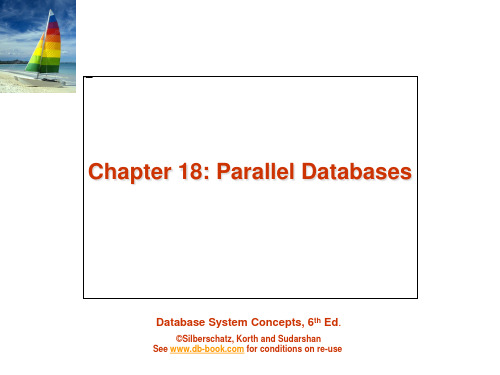
Database System Concepts - 6th Edition
18.4
©Silberschatz, Korth and Sudarshan
I/O Parallelism
Good for point queries on partitioning attribute
No clustering, so difficult to answer range queries
Database System Concepts - 6th Edition
18.9
©Silberschatz, Korth and Sudarshan
relational algebra)
makes parallelization easier.
Different queries can be run in parallel with each other.
Concurrency control takes care of conflicts.
Comparison of Partitioning Techniques (Cont.)
Range partitioning: Provides data clustering by partitioning attribute value. Good for sequential access Good for point queries on partitioning attribute: only one disk needs to
Introduction
数据库系统概论第一章总结
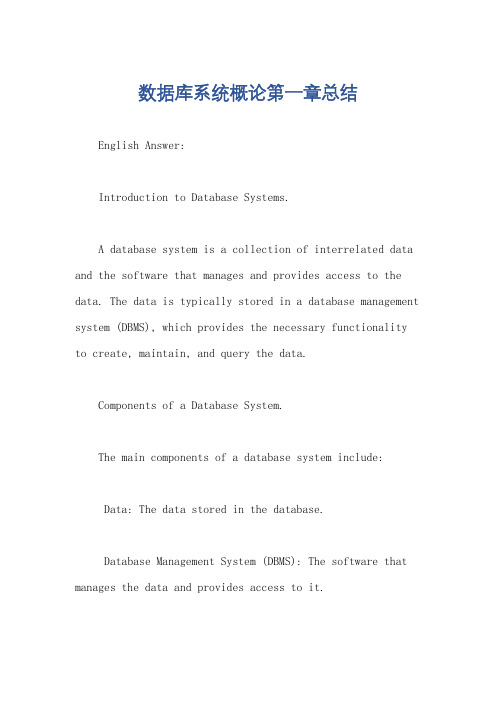
数据库系统概论第一章总结English Answer:Introduction to Database Systems.A database system is a collection of interrelated data and the software that manages and provides access to the data. The data is typically stored in a database management system (DBMS), which provides the necessary functionality to create, maintain, and query the data.Components of a Database System.The main components of a database system include:Data: The data stored in the database.Database Management System (DBMS): The software that manages the data and provides access to it.Users: The people who use the database system.Types of Databases.There are many different types of databases, each with its own strengths and weaknesses. The most common types of databases include:Relational databases: Relational databases store data in tables, which are made up of rows and columns. Each row represents a single record, and each column represents a particular attribute of the record.NoSQL databases: NoSQL databases are designed for storing and managing large amounts of unstructured data. They do not use the traditional table structure of relational databases.Object-oriented databases: Object-oriented databases store data in objects, which are made up of data and methods. Objects can be related to each other through inheritance and polymorphism.Database Design.Database design is the process of creating a database that meets the specific needs of the users. The goal of database design is to create a database that is efficient, reliable, and easy to use.Database Administration.Database administration is the process of managing the database system and ensuring that it is running smoothly. Database administrators are responsible for creating and maintaining the database, as well as monitoring its performance and security.Conclusion.Database systems are essential for managing and accessing data. They are used in a wide variety of applications, from small businesses to large corporations. By understanding the basics of database systems, you canbetter understand how to use them to meet your specific needs.Chinese Answer:数据库系统概述。
学术英语(理工)详解答案-Unit-1

Genetic engineering
– If the topic is too general, how do you narrow it down to a more manageable topic?
Universe
– Can you suggest some
appropriate topics of each
In which aspect do the two essays share the same idea? Both focus on the vulnerability of a computer.
9
Unit 1 Choosing a Topic
1 Deciding on a topic
In which aspect do the two essays differ?
U.S. Dollars. 16 __e_x_p_lo_i_t ___ (开拓) a new market in the city 17 be absorbed in the social _n_e_t_w_o_r_k_in_g_ (社交网络) 18 __i_n_v_o_lv_e___ (涉及) unnecessary extra charges 19 only one __in_s_t_a_n_ce___ (实例) out of many 20 get to know more about the _s_p_e_c_ifi_c_a_ti_o_n (具体的细节) of
Lecture 1 Questions Lecture 2 Questions Lecture 3 Questions
4
Unit 1 Choosing a Topic
1 Deciding on a topic
数据库系统概念(database system concepts)英文第六版 PPT 第11章

11.8
©Silberschatz, Korth and Sudarshan
Sparse Index Files (Cont.)
Compared to dense indices:
Less space and less maintenance overhead for insertions and deletions. Generally slower than dense index for locating records.
Database System Concepts - 6th Edition
11.3
©Silberschatz, Korth and Sudarshan
Index Evaluation Metrics
Access types supported efficiently. E.g.,
records with a specified value in the attribute or records with an attribute value falling in a specified range of values.
actual records with that particular search-key value.
Secondary indices have to be dense
Database System Concepts - 6th Edition 11.10 ©Silberschatz, Korth and Sudarshan
value in the file.
E.g. index on ID attribute of instructor relation
学术英语课后答案 unit1说课讲解

学术英语课后答案u n i t1学术英语理工教师手册Unit 1 Choosing a TopicI Teaching ObjectivesIn this unit , you will learn how to:1.choose a particular topic for your research2.formulate a research question3.write a working title for your research essay4.enhance your language skills related with reading and listening materials presented in this unitII. Teaching Procedures1.Deciding on a topicTask 1Answers may vary.Task 21 No, because they all seem like a subject rather than a topic, a subject which cannot be addressed even by a whole book, let alone by a1500-wordessay.2Each of them can be broken down into various and more specific aspects. For example, cancer can be classified into breast cancer, lung cancer, liver cancer and so on. Breast cancer can have such specific topics for research as causes for breast cancer, effects of breast cancer and prevention or diagnosis of breast cancer.3 Actually the topics of each field are endless. Take breast cancer for example, we can have the topics like:Why Women Suffer from Breast Cancer More Than Men?A New Way to Find Breast TumorsSome Risks of Getting Breast Cancer in Daily LifeBreast Cancer and Its Direct Biological ImpactBreast Cancer—the Symptoms & DiagnosisBreastfeeding and Breast CancerTask 31 Text 1 illustrates how hackers or unauthorized users use one way or another to get inside a computer, while Text2 describes the various electronic threats a computer may face.2 Both focus on the vulnerability of a computer.3 Text 1 analyzes the ways of computer hackers, while Text 2 describes security problems of a computer.4 Text 1: The way hackers “get inside” a computerText 2: Electronic threats a computer facesYes, I think they are interesting, important, manageable and adequate.Task 41Lecture1:Ten Commandments of Computer EthicsLecture 2:How to Deal with Computer HackersLecture 3:How I Begin to Develop Computer Applications2Answersmay vary.Task 5Answers may vary.2 Formulating a research questionTask 1Text 3Research question 1: How many types of cloud services are there and what are they? Research question 2: What is green computing?Research question 3: What are advantages of the cloud computing?Text 4Research question 1: What is the Web 3.0?Research question 2: What are advantages and disadvantages of the cloud computing? Research question 3: What security benefits can the cloud computing provide?Task 22 Topic2: Threats of Artificial IntelligenceResearch questions:1) What are the threats of artificial intelligence?2) How can human beings control those threats?3) What are the difficulties to control those threats?3 Topic3: The Potentials of NanotechnologyResearch questions:1) What are its potentials in medicine?2) What are its potentials in space exploration?3) What are its potentials in communications?4 Topic4: Global Warming and Its EffectsResearch questions:1) How does it affect the pattern of climates?2) How does it affect economic activities?3) How does it affect human behavior?Task 3Answers may vary.3 Writing a working titleTask 1Answers may vary.Task 21 Lecture 4 is about the security problems of cloud computing, while Lecture 5 is about the definition and nature of cloud computing, hence it is more elementary than Lecture 4.2 The four all focus on cloud computing. Although Lecture 4 and Text 4 address the same topic, the former is less optimistic while the latter has more confidence in the security of cloud computing. Text3 illustrates the various advantages of cloud computing.3 Lecture 4: Cloud Computing SecurityLecture 5: What Is Cloud Computing?Task 3Answers may vary.4 Enhancing your academic languageReading: Text 11.Match the words with their definitions.1g 2a 3e 4b 5c 6d 7j 8f 9h 10i2. Complete the following expressions or sentences by using the target words listed below with the help of the Chinese in brackets. Change the form if necessary.1 symbolic 2distributed 3site 4complex 5identify6fairly 7straightforward 8capability 9target 10attempt11process 12parameter 13interpretation 14technical15range 16exploit 17networking 18involve19 instance 20specification 21accompany 22predictable 23profile3. Read the sentences in the box. Pay attention to the parts in bold.Now complete the paragraph by translating the Chinese in brackets. You may refer to the expressions and the sentence patterns listed above.ranging from(从……到)arise from some misunderstandings(来自于对……误解)leaves a lot of problems unsolved(留下很多问题没有得到解决)opens a path for(打开了通道)requires a different frame of mind(需要有新的思想)4.Translate the following sentences from Text 1 into Chinese.1) 有些人声称黑客是那些超越知识疆界而不造成危害的好人(或即使造成危害,但并非故意而为),而“骇客”才是真正的坏人。
数据库系统概念(database system concepts)英文第六版 第一章
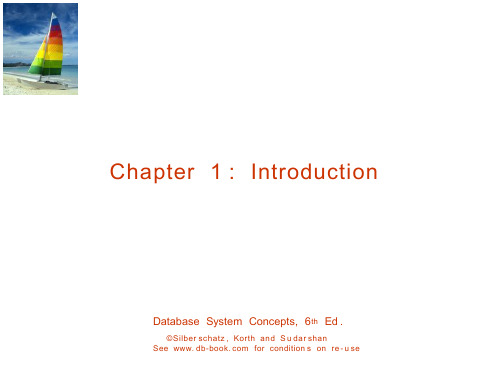
Databa se Sy stem Concept s - 6th Edition
1 .3
©Silber schatz , Korth and S u dar
n Relational model (Chapter 2) n Example of tabular data in the relational model Columns
_____ Rows
Databa se Sy stem Concept s - 6th Edition
1 .10
©Silber schatz , Korth and S u dar
n Physical Data Independence – the ability to modify the physical schema without changing the logical schema l Applications depend on the logical schema l In general, the interfaces between the various levels and components should be well defined so that changes in some parts do not seriously influence others.
1 .5
©Silber schatz , Korth and S u dar
n Phys ical level : describes how a record (e.g., customer) is stored. n Logical level : describes data stored in database, and the relationships among the data. type instructor = record ID : string;
数据库系统概念(database system concepts)英文第六版 PPT 第17章
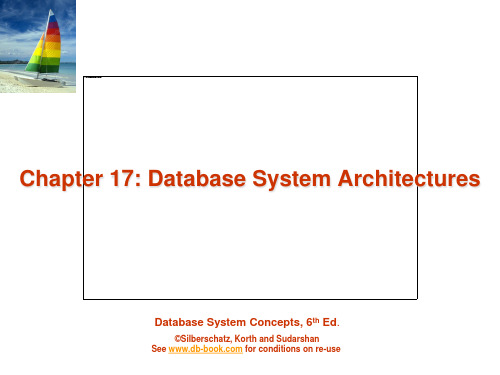
Database System Concepts - 6th Edition
17.3
© Silberschatz, Korth and Sudarshan
A Centralized Computer System
Database System Concepts - 6th Edition
17.4
© Silberschatz, Korth and Sudarshan
computer systems.
General-purpose computer system: one to a few CPUs and a number
of device controllers that are connected through a common bus that provides access to shared memory.
Checkpoint process
Performs periodic checkpoints
Monitors other processes, and takes recovery actions if any of the other processes fail
Process monitor process
Chapter 17: Database System Architectures
Centralized and Client-Server Systems Server System Architectures Parallel Systems Distributed Systems
better functionality for the cost flexibility in locating resources and expanding facilities better user interfaces easier maintenance
Database system concepts PPT

particular enterprise
Collection of interrelated data
Set of programs to access the data
An environment that is both convenient and efficient to use Defining structures for storage of information
1.9
©Silberschatz, Korth and Sudarshan
Basic Concepts: DB, DBMS
Database(DB): a collection of data for one or more purpose.
Database Management System(DBMS): contains information about a
file systems.
Example: a bank needs to keep information about all customers and
saving accounts.
Drawbacks of using file systems to store data:
Data redundancy and inconsistency
1.5
©Silberschatz, Korth and Sudarshan
Course Introduction
Final result?
Laboratory: 30 p Theory: 70p
Exam in the middle of the school term: 10 p Exam in the end of the school term: 60 p
数据库系统概念(database system concepts)英文第六版 PPT 第15章
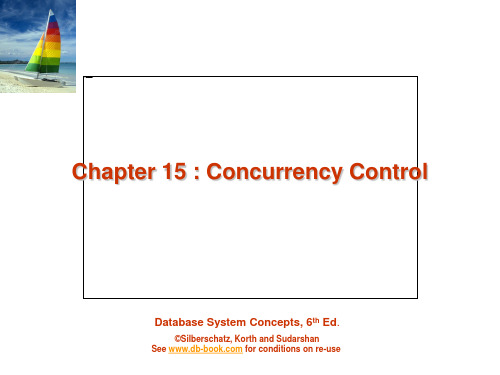
requesting and releasing locks. Locking protocols restrict the set of possible schedules.
Database System Concepts - 6th Edition
15.5
©Silberschatz, Korth and Sudarshan
The Two-Phase Locking Protocol (Cont.)
There can be conflict serializable schedules that cannot be obtained if
two-phase locking is used.
However, in the absence of extra information (e.g., ordering of access
to data), two-phase locking is needed for conflict serializability in the following sense: Given a transaction Ti that does not follow two-phase locking, we can find a transaction Tj that uses two-phase locking, and a schedule for Ti and Tj that is not conflict serializable.
©Silberschatz, Korth and Sudarshan
Lock-Based Protocols (Cont.)
Lock-compatibility matrix
数据库系统概念(database system concepts)英文第六版 PPT 第六章
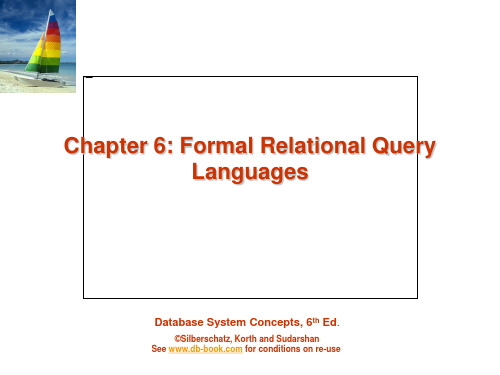
Database System Concepts - 6th Edition
6.8
©Silberschatz, Korth and Sudarshan
Union Operation
Notation: r s Defined as:
r s = {t | t r or t s}
©Silberschatz, Korth and Sudarshan
Cartesian-Product Operation – Example
Relations r, s:
r x s:
Database System Concepts - 6th Edition
6.12
©Silberschatz, Korth and Sudarshan
Project Operation
Notation:
A , A , , A 1 2 k
(r )
where A1, A2 are attribute names and r is a relation name.
The result is defined as the relation of k columns obtained by erasing
For r s to be valid.
1. r, s must have the same arity (same number of attributes) 2. The attribute domains must be compatible (example: 2nd column of r deals with the same type of values as does the 2nd column of s)
数据库系统概论英文教材

数据库系统概论英文教材Data Management Systems: A Comprehensive OverviewData management systems have become an integral part of our digital landscape, enabling organizations to efficiently store, organize, and retrieve vast amounts of information. These systems, commonly known as database management systems (DBMS), have evolved significantly over the years, offering advanced features and capabilities that cater to the ever-growing demands of data-driven enterprises.At the core of a data management system lies the database, which serves as a centralized repository for structured data. Databases can take various forms, such as relational, NoSQL, or object-oriented, each with its own unique characteristics and use cases. Regardless of the specific type, the primary function of a database is to provide a secure, reliable, and scalable means of storing and managing data.One of the key components of a data management system is the database management system software, which acts as an intermediary between the database and the applications or users that interact with it. The DBMS provides a set of tools andfunctionalities that facilitate the creation, maintenance, and manipulation of the database, ensuring the integrity, security, and performance of the data.The DBMS typically includes features such as:1. Data Definition Language (DDL): This component allows users to define the structure of the database, including the creation, modification, and deletion of tables, indexes, and other database objects.2. Data Manipulation Language (DML): The DML enables users to perform operations such as inserting, updating, deleting, and querying data within the database.3. Transaction Management: The DBMS ensures the integrity of data by providing mechanisms for managing transactions, which are a series of operations that must be completed as a single, indivisible unit.4. Concurrency Control: This feature ensures that multiple users or processes can access and modify the same data simultaneously without compromising data integrity.5. Security and Access Control: The DBMS implements securitymeasures to protect the database from unauthorized access, data breaches, and other security threats.6. Backup and Recovery: The DBMS provides tools and procedures for regularly backing up the database and recovering data in the event of system failures or data loss.7. Query Optimization: The DBMS employs various techniques to optimize the execution of complex queries, ensuring efficient data retrieval and performance.Beyond the core DBMS functionalities, modern data management systems often incorporate additional components and technologies to enhance their capabilities. These may include:1. Data Warehousing: Data warehouses are specialized databases designed for analytical and reporting purposes, enabling organizations to consolidate and analyze large volumes of data from various sources.2. Business Intelligence (BI) and Analytics: BI tools and analytical capabilities integrated with the data management system allow organizations to extract insights, identify trends, and make data-driven decisions.3. Big Data Management: With the exponential growth of data, data management systems have evolved to handle large-scale, unstructured data, often leveraging technologies such as Hadoop, NoSQL databases, and stream processing.4. Cloud-based Data Management: The rise of cloud computing has led to the development of cloud-based data management services, offering organizations the flexibility, scalability, and cost-effectiveness of managing their data in the cloud.5. Data Governance and Metadata Management: Effective data management requires comprehensive data governance policies and metadata management, ensuring the quality, security, and compliance of data across the organization.As organizations continue to generate and collect vast amounts of data, the importance of robust data management systems cannot be overstated. These systems play a crucial role in enabling organizations to harness the power of their data, drive informed decision-making, and gain a competitive edge in the digital landscape.In conclusion, data management systems are the backbone of modern data-driven organizations, providing the necessary tools and infrastructure to store, manage, and leverage data effectively. Byunderstanding the core components and capabilities of these systems, organizations can optimize their data management strategies and unlock the full potential of their data assets.。
六级阅读高端必备词汇
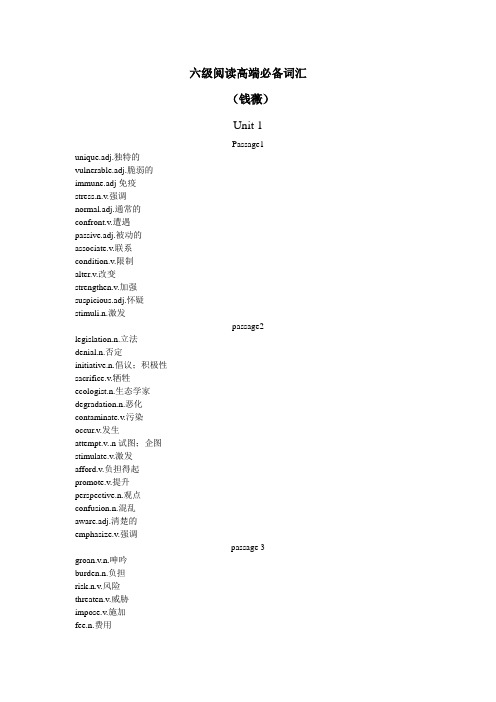
六级阅读高端必备词汇(钱薇)Unit 1Passage1 unique.adj.独特的vulnerable.adj.脆弱的immune.adj免疫stress.n.v.强调normal.adj.通常的confront.v.遭遇passive.adj.被动的associate.v.联系condition.v.限制alter.v.改变strengthen.v.加强suspicious.adj.怀疑stimuli.n.激发passage2 legislation.n.立法denial.n.否定initiative.n.倡议;积极性sacrifice.v.牺牲ecologist.n.生态学家degradation.n.恶化contaminate.v.污染occur.v.发生attempt.v..n试图;企图stimulate.v.激发afford.v.负担得起promote.v.提升perspective.n.观点confusion.n.混乱aware.adj.清楚的emphasize.v.强调passage 3groan.v.n.呻吟burden.n.负担risk.n.v.风险threaten.v.威胁impose.v.施加fee.n.费用admission.n入学;同意.gap.n.差距revenue.n.收入scrap.v.刮;擦cutback.n.削减strain.n.压力tuition.n.学费suspend..v.悬空;缓期boom.n.繁荣;大量增加soar.v.翱翔;攀升enroll.v.报名revolutionary.adj.革命性的.passage 4 premise.n.前提detect.v.探测inspect.v.检查abuse.v.滥用;虐待chip.n.细长条;薯条;芯片sort out区分current.n.气流;水流;电流artificial.adj.人造的monitor.n.监测locate.v.定位neglect.v.忽略hazard.n.危险essential.adj.重要的simulate.v.模拟sensitive.adj.敏感的evaporate.v.蒸发Unit 2Passage 2 concept.n.概念industry.n.产业;工业concentration.n浓度;集中精神.striking.adj.惊人的clear-cut清楚的practice.n.v.练习available.adj.可得的;现有的dispose.v.处理scale.n.规模v.称量illustrate.v.解释;展示appeal to吸引;呼吁characteristic.n.特点impact.n.冲击力consequence.n.后果cater to迎合approach.n.方法;途径.Unit 3passage2 artificial intelligence人工智能nowhere一点也不resemble.v.相像aspiration.n.期望never mind更不用说abstract.adj.抽象的adapt.v.适应molecule.n.分子incapable.adj.不能的notion.n.概念prospect.n.前途passage 3 issue.n.事件v.发表;公布average.v.平均accessible.adj可得的option.n.选择alternative.adj另一种的.sustain.v.持续margin.n.空白dense.adj.密集的mass transit.v.大众交通emit.v.散发well-being健康;福利gap.n.沟壑protest.v.抗议;维护account for解释passage 4 attract.v.吸引specialty.n专卖店demand.n.需求supply.n.供应selective.adj.挑选性的load.v.装载prohibitive.ad禁止的j.evoke.v.挑起enhance.v.加强distribute.v.销售;分布;散播retail.v.零售wholesale.n.批发discount.n.打折evaluate.v.评估Unit 4passage1 alert.v.警醒behaviorally.adv.下意识的simultaneous.adj.同时的long-standing长期的hemisphere.n.半球evolve.v.进化;演化doze.v.打盹reflection.n.反映;反射;深思companion.n.同伴surface.v.浮到---表面drown.v.淹死security.n.安全emerge.v.突现insight.n.洞察tip of iceberg冰山一角speculate.v.预测;投机species.n.物种passage2 decade.n.十年demonstrate.v.展示turn down拒绝energy field 能量场take sth seriously认真对待no better than和---一样reveal.v.揭示deceive.v.欺骗sense.v.感知single-handed单枪匹马;一个人cure.v.治愈approve.v.同意;许可therapy.n.治疗方案;配方leading.adj.一流的nothing more than只不过是mere.adj.只是passage 3 distinct.adj.特别的drawing board画板lane.n.小巷;路途capacity.n.容量;能力specify.v.细化destination.n.终点available.adj.可得的alternative.adj.另一个的vessel.n.船只vehicle.n.车辆release.v.释放wheel.n.轮子modify.v.修改minor.adj.次要的major.adj.主要的harmonize.v.和谐watch out for提防assign.v.安排;布置passage 4 invade.v.侵略myth.n.谜语prevalent.adj.流行的prejudice.n.偏见certificate.n.证书indicator.n.象征;指标depress.v.压抑root.v.根源于are but除了trying.adj.尝试的conflict.v.冲突compromise.v.妥协eliminate.v.去除self-fulfillment自我满足eventual.adj.最终的emphasize.v.强调Unit 5passage1 casualness.n.随意universal.adj.普骗的assume.v.假设;认为casual.adj.休闲的condition.v.限制interpret.v.解释proper.adj.恰当的affair.n.事件still adj.静止的arrogant.adj.barrier.n.障碍obstacle.n.障碍isolate.v.隔离acquaint.n.熟悉的ignore.v.忽略maintain.v.保持other than不是cluster.v.聚集significant.adj.重要的passage 2 sophisticated.adj.复杂的;高级的for sake of为---着想;为----考虑functional.adj.功能性的;有用的attempt.n..v.企图;试图variety.n.种类;变化affection.n.情感vulnerable.adj.脆弱的fragile.adj.脆弱的boycott.v.抵制myth.n.神话regargless不管;不顾show off卖弄;显摆ironic.adj.讽刺的convince.v.确信defense.v.防御;抵抗passage 3 evidence.n.证据elementary.adj.基础的;重要的afford.v.负担;承受luxurious.adj.昂贵的concentrate.v.集中perception.n.理解;视觉distraction.n.打扰essential.adj.重要的;核心的bleak.adj.微弱的attentive.adj.专注的analyze.v.分析alarm.n.警钟;警告input.n.输入impressive.adj.印像深刻的ignorance.n.天真;无罪passage 4 imperative.n.动机explore.v.探索compell.v.逼迫track.n..v.追踪stake.n.赌注highlight.v.突出abundant.adj.丰富的mounting.adj.大量的accomplish.v.完成colonize.v.殖民化pursue.v.追寻induce.v.引发fossil.n.化石bacteria.n.细菌virus.n.病毒confirm.v.确认data.n.数据Unit 6passage1 navigational.adj.航行的;行驶的signal.n.信号;标志combine sth with把----结合在一起identical.adj.相同的promote.v.促进;提升potential.adj.潜在的detect.v.探测maturity.n.成熟superiority.n.优越性;fluctuate.v.起伏;波动database.n.数据库luxury.n.奢侈品vocal.adj.声音的display.v.展示immaturity.n.不成熟guidance.n.指导passage 2 tear.v.撕碎offer.v.提供complain.v.抱怨triple.v.三倍disgusting.adj恶心的.run out用完response.n.反应conserve.v.保存arise.v.出现undesirable.adj.不想要的innovation.n.创新substitute.v.代替entity.n.实体ruin.v.毁灭curb.v.限制stumble.v.绊脚;蹒跚passage 3 minority.n.少数民族go out of fashion过时paradox.n.悖论ban.v..n.禁止discriminate.v.歧视deny.v.否定factor.v.利用.n.因素sensitive.adj.敏感的adopt.v.收养;采纳agency.n.代理机构valid.adj.有效的oppose.v.反对deprive.v.剥夺racial.adj.种族的confront.v.遭遇aggravate.v.恶化prescribe.v.开(处方)advocate.v.提倡shift.n.v.转换;切换passage 4 loose.adj.松散的superficial.adj.表面的acquaintance.n.熟人sweep.v.打扫crime.n.罪行detail.n.细节impersonal.adj.非个人的suspicious.adj.怀疑的tolerant.adj.容忍的the more----the more---越-----越-----alien.n.外来物contrast.v.相反disrupt.v.打扰symptom.n.z症状Unit 7passage1 strategy.n.策略starvation.n.灾荒;饿死transform.v.转化existence.n.存在piece together拼凑stretch.v.拉升impact.n.冲击力;影响力evolution.n.演化;进化ancestor.n.祖先expansion.n.扩张rise.v.升起dramatic.adj.戏剧性的be obliged to被迫original.adj.原来的former.adj.前者accompany.v.陪同accelerate.v.加速be bound to一定会substantial.adj.大量的passage 2 odd.adj.奇怪的virtue.n.优点refrain.v.制止sin.n.罪行fuel.v.加油n燃料.hazard.n.危险overall.adj.总体的fantasy.n.神话;奇迹attribute to导致diet.n.饮食;节食salvation.n.救世军moral.adj.道德的fatal.adj.致命的virtuous.adj.有利的slim.adj.苗条的deadly.adj.致命的sociology.n.社会学passage 3 impulse.n.冲动aggressive.adj.暴力的evidence.n.证据revenge.n.v.报复assume.v.承担sacrifice.v.牺牲commitment.n.责任;义务physical.adj.物理的;身体的offense.n.惹怒;得罪victim.n.受害者loyalty.n.忠诚motive.n.动机objective.n.目标adj.客观的survival.n.存活passage 4 ethnic.adj.少数民族的bias.n.偏见precaution.n.;提醒;警告;小心extended family大家庭be inclined to倾向做某事former.adj.前者latter.adj.后者questionnaire.n.问卷调查interactive.adj.互动的specific.adj.特定的adapt.v.适应comprehend.v.理解tie.n.结;联系v.打结Unit 8passage 1 criticism.n.批判raise.v.提起bear.v.忍受;承担;campus.n.校园pure.adj.纯净的discipline.n.学科;纪律inspire.v.激发envious.adj.嫉妒的appreciative.adj.欣赏的complain.v.抱怨;投诉greedy.adj.贪婪的cherish.v.珍爱academic.adj.学术的commerce.n.商业passage 2precedent.adj.之前的rash.n.皮疹;大量出现motivate.v.鼓动compensation.n.赔偿legal.adj.合法的negligence.n.忽略potential.adj.潜在的claim.n.v.宣称;投诉resist.v.抵抗sue.v.起诉poverty.n.贫穷soar.v.翱翔;高涨drain.n.放干;排水float.v.漂浮pace.n.节奏;步伐passage 3 authority.n.权威supervisor.n.监督者;主管人district.n.街区exclusive.adj.独家的;排外的pressure---into---施加压力debate.n.讨论;辩论protest.v.辩解response.n.反应complexity.n.复杂性acknowledge.v.承认legislation.n.立法passage 4 enormous.adj.大量的convert.v.转化ritual.n.礼节seek.v.追求definition.n.定义hollow.adj.空洞的fruitless.adj.无果的retail.v.零售worship.v.崇拜thrive.v.茂盛;繁荣alleviate.v.减轻aggravate.v.恶化Unit 9passage1amaze.v.惊讶;吃惊community.n.社区trick.v..n.小把戏evil.adj.罪恶的intend.v.打算issue.v.发行;发布.n事件;期刊inhabitant.n.居民security.n.安全;债券enthusiastic.adj.热情的strengthen.v.加强priority.n.优先;burgle.v.闯入try out尝试passage 2 conviction.n.信仰;信念obliged.adj.被迫dull.adj.枯燥的intellect.n.智力uneven.adj.不平均的merit.n.优点bearing.n.行为conform.v.一致comprehend.v.理解recommend.v.推荐commend.v.赞赏;表扬gown.n.袍子lecture.n.授课passage 3 fund.n.基金raise.v.提高take the case of拿----来说advance.n.v.前进legal.adj.合法的trend.n.潮流leisure.n.休闲的relief.n.轻松;救济ruin.n.v.毁灭cope with处理;对待allocate.v.分配maintain.v.保持better off更好federal.adj.联邦的appropriate.v.合理分配passage 4contact lens隐形眼镜defect.n.缺点enhance.v.加强transmit.v.传输disposable.adj.抛弃的;处理的astronomical.adj.天文学的individualized.adj.个人的semi----一半的--laser.n.激光purchase.n.v.购买process.n.过程v.加工Unit 10Passage 1 modest.adj.少量的;谦虚的shortfall.n.短缺evaluate.v.评估clinic.n.门诊raise.v.提出dose.n.剂量excessive.adj.过多的balanced.adj.平横的make sense有意义cure.v. n..治愈deficiency.n.缺陷supplement.n.补充side effect副作用artery.n.动脉block.n.街区v.阻碍rational.adj.理性的outweigh.v.超过risk.n.风险.v.冒险Passage 2 defy.v.违抗signal.n.v.信号;标示for the time being暂时fulfillment.n.满足dominate.v.独占boss.v.指使----作----;使唤----live up to expectation达到期望suspect.n.v.怀疑loyalty.n.忠诚vary from case to case因事而异futurologist.n.预言家portend.v.表明hypothesis.n.假设downturn.n.向下的趋势cage.n笼子.v.困住passage 4 driving force推动力virtual.adj.现实的surgeon.n.外科医生mobile.adj.移动的command.n.命令v.指挥angle.n.角度magnify.v.放大tedious.adj.乏味的precision.n.准确recover.v.恢复battlefield.n.战场miniature.n.微缩robot.n.机器人remote-control远程遥控.Unit 11passage 1 survive.v.存活tragedy.n.悲剧deadly.adj.致死的tilt.v.倾斜heroine.n.女主角equate sth with把----等同acknowledge.v.承认casualty.n.死伤人数guilty.adj.有罪的offend.v.惹怒;冒犯present.v.呈交adj.现在的depict.v.描绘submarine.n潜水艇.aboard.国外lean.adj.瘦弱的desperate.adj.绝望的scream.v.尖叫dwell.v.居住;唠叨pregnant.adj.怀孕的catastrophe.n.灾难sink.v.沉下dominant.adj垄断的.earn.v.赚得victim.n.受害者passage 2 inspire.v.激励;鼓动given如果;假设distinction.n区别;差异.dull.adj.乏味的arrogant.adj.傲慢的domain.n.邻域cater to迎合enroll.v.报名;加入quote.v.引用illustrate.v.描绘contradict.v.相反;抵触systematic.adj.系统的root.n.根源gifted.adj天才的passage 3 spy.n.间谍v.侦查track.v.追查n.痕迹charge.v.收费;充电n费用.profit.n.利益v.赢利confidential.adj绝密的.intensify.v.加强turn a blind eye to置之不理be inclined to倾向于做---deadline.n.最后期限reveal.v.揭露extension.n.延长;延期self-regulation自我约束trial.n.审判;尝试ban.n..v.禁止passage 4 immigrant.n.移民mess.n.一团糟terrorist.n.恐怖主义者shrewd.adj.精明的factor.n.因素v.利用expired visa过期签证keep track of追踪overstay.v.滞留intention.n.打算;企图House.n.国会lobby.n.游说组织division.n.分歧;分裂focus on着重privilege.n.特权hospitality.n.友好;热情coordinate.v.合作liberal.adj.自由的overemphasize.v.过度强调database.n.数据库enforcement.n.加强deportation.n.遣送出境Unit 12passage 1 blame.v.责备yield to屈服于wear out 用尽;耗光summon.v.号召outgrow.v.增长得超过exhaust.v.耗尽accustomed.adj习惯于.console.v.安慰grief.n.悲痛neglect.v.忽略infancy.n.婴儿officiate.v.正式出席deceased.adj.过世的element.n.成分;基本元素notion.n.观点mystery.n.谜语;神话sensible.adj.明智的passage 2 frustrate.v.沮丧trash.n.垃圾toxic.adj.有毒的hazard.n.危险lead.n.铅grave yard墓地exert.v.施加rally.n.联合recycle.v.回收protest.v.抗议initiative.adj.提议;主动性amendment.n.补充dump.n.v.倾倒upgrade.v.升级hesitate.v.犹豫passage 3 diversity.n.多样性peer.n.同辈coherent.adj.连接的strategy.n..策略implement.v.修正案tailor.n.裁缝;v.修改institute.v.发布;制定vitality.n.重要性flaw.n.缺点intensive.adj.加强的stress.v.强调.n.压力scope.n.眼界;邻域scratch.v.抓挠analysis.n.分析decentralized.adj.非集中化的vision.n.视线;视野focused.adj.集中的curricula.n.课程表passage 4 clone.v.n.克隆impractical.adj.不现实的selectively.adv挑选性地outcome.n.结果doom.v.注定progress.n.v.进步modify.v.修改immune.adj.免疫的defective.adj.缺陷的maturity.n.成熟endanger.v.濒危insight.n.洞察reproductive.adj.生殖的;繁衍的duplicate.v.复制品temperament.n脾气.species.n.物种Unit 13passage 1 fertile.adj.肥沃的organic.adj.有机的scale.n.范围v.称量jungle.n.雨林v挣扎.civilization.n.文明composition.n.组成;作文stable.adj.稳定的ingredient.n.成分pottery.n.陶器vegetation.n.植被topsoil.n.表层土hamper..v.妨碍slash-and-burn砍伐焚烧clear.v.清除carbon.n.碳origin.n.源头diminish.v.减少passage 2 gloomy.adj.灰暗的irresistible.adj.不可抗拒的democracy.n.民主individualistic.adj.个人的privatization.n.私有化afford.v.负担得起boom.v.n.繁荣raise.v.提出;升高over-whelming.adj.过多的;颠覆性的embrace.v.拥有foster.v.培养;鼓励contemplate.v考虑;.passage 3 accuse.v.起诉bacteria.n.细菌release.v.释放discipline.n.原则;学科silence.v.让----不说话n.安静organism.n.组织;生物approval.n.同意;许可exaggerate.v.夸张harass.v.骚扰;侵扰attempt.n.v.试图opposition.n.反对adverse.adj.反面的extensive.adj.广泛的appease.v.安慰passage 4go on strike罢工affective.adj.影响的disorder.n.混乱;病症depression.n.沮丧mental.adj.精神的reputable.adj.有名望的drawback.n.落后;弱点adjustment.n.调整light-hearted轻松的addicted.adj.成瘾的consult.v.咨询emit.v.释放;排放correspond.v.符合;类似;通信Unit 14passage 1 manipulate.v.操纵spoil.v.宠坏persistent.adj.坚持的campaign.v .邻导运动exert.v.施加resolve.v.决定;解决squeeze.v.n.挤压irony.n.讽刺facility.n.设备;设施counsel.n.咨询carrot-stick policy恩威并施irrational.adj.不合理的save.v.节省;存下blame.v.n.责备catastrophe.n.灾难passage 2 attain.v.达到fire.v.点燃n.火reward.n.v.回报industry.n.工业;行业;努力rag.n.破布;碎片haunt.v.萦绕strive.v.奋力essence.n.精华exploitation.n.利用;开发oppression.n.压抑origin.n.起源aspect.n.方面indicator.n.指标contradict.v.相反passage 3 stem.v.源于boundary.n边界.blur.v.模糊manufacture.v.生产justify.v.辩解;使—合理化in terms of在----方面呢tailor.n.v.修改reservation.n.保留意见;成见hostile.adj.敌意的consult.v.咨询complain.v.抱怨;投诉expenditure.n.花费impress.v.留下----印象pursue.v.追求compliance.n.服从pronouncement.n.声明;公告passage 4 global.adj.全球的consequence.n.后果breakthrough.n.突破alter.v.更换constrain.n.限制destruct.v.摧毁innovation.n.创新outdated.adj.过时的superficial.adj.表面的preference.n.偏好fuel.n.燃料v.点燃specialized.adj.专门的penetrate.v.穿透startle.v.惊吓invest.v.投资overlook.v.忽略eliminate.v.清除;淘汰radical.adj激进的Unit 16passage 1 appraise.n.估量distress.v.悲痛perspiration.n.出汗mechanism.n.机制survival.n.存活incredible.adj.难以置信的constructive.adj建设性的.indulge.v.卷入self-defense自卫instinctive.adj.本能的elaborate.adj.复杂的;精心准备的predictable.adj.可预测的belt-tightening勒紧皮带ridiculous.adj.可笑的cautious.adj小心的passage 2 disgusting.adj.恶心的lust.n.诱惑frustration.n.沮丧executive.n.行政人员ethic.adj.道德的boardroom.n.会议室motive.n.动机fertile.adj.肥沃的longstanding.adj.长期的keen.adj.渴望的intense.adj.强烈的tactic.n.策略scandle.n.丑闻fierce.adj.强烈的gain upper hand占上风legal.adj.合法的contract.v.缩小;传染;订合同n.合同Unit 17passage 1 symbolic.adj.代表的ideal.adj.理想的gender.n.性别norm.n.规范dominate.v.垄断withdraw.v.退后;抽出elevate.v.提升outcry.n.大喊feminization.n女性化.corrupt.v.贿赂maturity.n.成熟refinement.n.精炼;升华role play角色扮演authority.n.权威masculine.adj.男性化的sentiment.n.感情stereotype.n.老套的inevitable.adj.不可避免的defiance.n.违抗passage 2 breed.v.繁殖;培养materialism.n.物质主义layoff.n.下岗工人disposable.adj.处理的;抛弃的boom.n.繁荣statistic.adj.统计数字guarantee.v.保证promote.v.提升evil.adj.邪恶的distribute.v.散布;销售inflation.n.通货膨胀secure.v.保证living standard生活水平misery.n.悲惨stability.n.稳定性Unit 18passage 1 treat.v.对待suspect.v.怀疑casual.adj.随意的acquaint.adj.熟悉deserve.v.应得inferior.adj.低级的superior.adj.高级的respectable.adj.可敬的occupation.n.职业manual.adj.手工的profession.n.专业absorb.v.吸收absent-minded心不在焉embarrass.v.尴尬cater to迎合generosity.n.慷慨humble.adj.卑微的passage 2 inequality.n.不公平billionaire.n亿万富翁.fate.n.命运gains.n.收获ladder.n.阶梯in a row连续的bankruptcy.n.破产live with忍受sustain.v.维持obstacle.n.障碍integration.n.融合bargain.n.便宜货v.讨价还价conscious.adj.有意识的sensitive.adj.敏感的inevitable.adj.不可避免的allocate.v.分配border.n.边境。
数据库系统概念(database system concepts)英文第六版 PPT 第五章
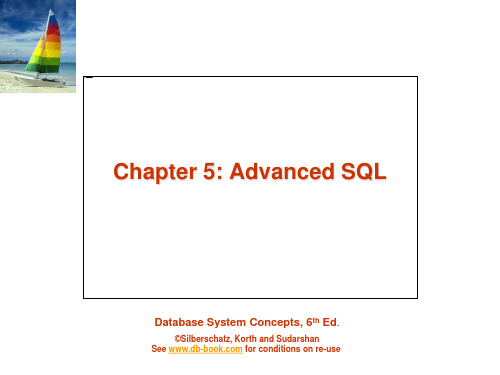
"select * from instructor where name = ‟" + name + "‟" Suppose the user, instead of entering a name, enters: X‟ or ‟Y‟ = ‟Y then the resulting statement becomes: "select * from instructor where name = ‟" + "X‟ or ‟Y‟ = ‟Y" + "‟" which is: select * from instructor where name = ‟X‟ or ‟Y‟ = ‟Y‟ User could have even used X‟; update instructor set salary = salary + 10000; - Prepared statement internally uses: "select * from instructor where name = ‟X\‟ or \‟Y\‟ = \‟Y‟ Always use prepared statements, with user inputs as parameters
How is this useful?
Database System Concepts - 6th Edition
5.10
©Silberschatz, Korth and Sudarshan
Metadata (Cont)
Database metadata DatabaseMetaData dbmd = conn.getMetaData();
DB_Management_3_2010[1]
![DB_Management_3_2010[1]](https://img.taocdn.com/s3/m/095f5c0d6c85ec3a87c2c56a.png)
Database Systems a Lecture 03.11.2010
Course project
Students will form project groups and define a database system Project documentation contains a log book, project document, presentations slides Contents of the project document:
Relationship Types, Sets and Instances
A relationship type R among n entity types E1, E2, . . ., En defines a set of associations or a relationship set-among entities from these types. As for entity types and entity sets, a relationship type and its corresponding relationship set are customarily referred to by the same name R. Each relationship instance r1 in R is an association of entities, where the association includes exactly one entity from each participating entity type. Each such relationship instance ri represents the fact that the entities participating in ri are related in some way in the corresponding miniworld situation. For example, consider a relationShip type WORKS_FOR between the two entity types EMPLOYEE and DEPARTMENT, which associates each employee with the department the employee works for Each relationship instance in the relationship set WORKS_FOR associates one employee entity and one department entity.
- 1、下载文档前请自行甄别文档内容的完整性,平台不提供额外的编辑、内容补充、找答案等附加服务。
- 2、"仅部分预览"的文档,不可在线预览部分如存在完整性等问题,可反馈申请退款(可完整预览的文档不适用该条件!)。
- 3、如文档侵犯您的权益,请联系客服反馈,我们会尽快为您处理(人工客服工作时间:9:00-18:30)。
Unit-1 Database System Concept Lecture-5Hi! Welcome to the fascinating world of DBMS. Here in this lecture we are going to discuss about the Relational Model.We have discussed the E-R Model, a technique for building a logical model of an enterprise. Logical models are high level abstract views of an enterprise data. In building these models little thought is given to representing or retrieving data in the computer. At the next lower level, a number of data models are available that provide a mapping for a logical data model like the E-R model. These models specify a conceptual view of the data as well as a high level view of the implementation of the database on the computer. They do not concern themselves with the detailed bits and bytes view of the data. What is relational model? The relational model was proposed by E. F. Codd in 1970. It deals with database management from an abstract point of view. The model provides specifications of an abstract database management system. The precision is derived from solid theoretical foundation that includes predicate calculus and theory of relations. To use the database management systems based on the relational model however, users do not need to master the theoretical foundations. Codd defined the model as consisting of the following three components: Data Structure - a collection of data structure types for building the database. Data Manipulation - a collection of operators that may be used to retrieve, derive or modify data stored in the data structures. Data Integrity - a collection of rules that implicitly or explicitly define a consistent database state or changes of states.Page No 1Unit-1 Database System Concept Lecture-5 Data Structure Often the information that an organization wishes to store in a computer and process is complex and unstructured. For example, we may know that a department in a university has 200 students, most are full-time with an average age of 22 years, and most are females. Since natural language is not a good language for machine processing, the information must be structured for efficient processing. In the relational model the information is structures in a very simple way. The beauty of the relational model is its simplicity of structure. Its fundamental property is that all information about the entities and their attributes as well as the relationships is presented to the user as tables (called relations) and nothing but tables. The rows of the tables may be considered records and the columns as fields. Each row therefore consists of an entity occurrence or a relationship occurrence. Each column refers to an attribute. The model is called relational and not tabular because tables are a lower level of abstractions than the mathematical concept of relation. Tables give the impression that positions of rows and columns are important. In the relational model, it is assumed that no ordering of rows and columns is defined. We consider the following database to illustrate the basic concepts of the relational data model.Figure 3.1 A simple student database We have not included the attributes in the above E-R diagram. The attributes are student id, student name and student address for the entity set student and subject number, subject name and department for the entity set subject.Page No 2Unit-1 Database System Concept Lecture-5 The above database could be mapped into the following relational schema which consists of three relation schemes. Each relation scheme presents the structure of a relation by specifying its name and the names of its attributes enclosed in parenthesis. Often the primary key of a relation is marked by underlining. student(student_id, enrolment(student_id, subject(subject_id, subject_name, department) An example of a database based on the above relational model is: student_name, address) subject_id)Table 1. The relation studentTable 2. The relation enrolmentPage No 3Unit-1 Database System Concept Lecture-5 Table 3. The relation subject We list a number of properties of relations: Each relation contains only one record type. Each relation has a fixed number of columns that are explicitly named. Each attribute name within a relation is unique. No two rows in a relation are the same. Each item or element in the relation is atomic, that is, in each row, every attribute has only one value that cannot be decomposed and therefore no repeating groups are allowed. Rows have no ordering associated with them. Columns have no ordering associated with them (although most commercially available systems do). The above properties are simple and based on practical considerations. The first property ensures that only one type of information is stored in each relation. The second property involves naming each column uniquely. This has several benefits. The names can be chosen to convey what each column is and the names enable one to distinguish between the column and its domain. Furthermore, the names are much easier to remember than the position of the position of each column if the number of columns is large. The third property of not having duplicate rows appears obvious but is not always accepted by all users and designers of DBMS. The property is essential since no sensible context free meaning can be assigned to a number of rows that are exactly the same. The next property requires that each element in each relation be atomic that cannot be decomposed into smaller pieces. In the relation model, the only composite or compound type (data that can be decomposed into smaller pieces) is a relation. This simplicity of structure leads to relatively simple query and manipulative languages.Page No 4Unit-1 Database System Concept Lecture-5 A relation is a set of tuples. As in other types of sets, there is no ordering associated with the tuples in a relation. Just like the second property, the ordering of the rows should not be significant since in a large database no user should be expected to have any understanding of the positions of the rows of a relation. Also, in some situations, the DBMS should be permitted to reorganize the data and change row orderings if that is necessary for efficiency reasons. The columns are identified by their names. The tuple on the other hand are identified by their contents, possibly the attributes that are unique for each tuple. The relation is a set of tuples and is closely related to the concept of relation in mathematics. Each row in a relation may be viewed as an assertion. For example, the relation student asserts that a student by the name of Reena Rani has student_id 8654321 and lives at 88, Long Hall. Similarly the relation subject asserts that one of the subjects offered by the Department of Computer Science is CP302 Database Management. Each row also may be viewed as a point in a n-dimensional space (assuming n attributes). For example, the relation enrolment may be considered a 2-dimensional space with one dimension being the student_id and the other being subject_id. Each tuple may then be looked at as a point in this 2-dimensional space. In the relational model, a relation is the only compound data structure since relation does not allow repeating groups or pointers. We now define the relational terminology: Relation - essentially a table Tuple - a row in the relation Attribute - a column in the relation Degree of a relation - number of attributes in the relation Cardinality of a relation - number of tuples in the relation N-ary relations - a relation with degree N Domain - a set of values that an attribute is permitted to take. Same domain may be usedPage No 5Unit-1 Database System Concept Lecture-5 by a number of different attributes. Primary key - as discussed in the last chapter, each relation must have an attribute (or a set of attributes) that uniquely identifies each tuple. Each such attribute (or a set of attributes) is called a candidate key of the relation if it satisfies the following properties: (a) The attribute or the set of attributes uniquely identifies each tuple in the relation (called uniqueness), and (b) if the key is a set of attributes then no subset of these attributes has property (a) (called minimality). There may be several distinct set of attributes that may serve as candidate keys. One of the candidate keys is arbitrarily chosen as the primary key of the relation. The three relations above student, enrolment and subject have degree 3, 2 and 3 respectively and cardinality 4, 6 and 5 respectively. The primary key of the relation student is student_id, of relation enrolment is (student_id, subject_id), and finally the primary key of relation subject is subject_id. The relation student probably has another candidate key. If we can assume the names to be unique than the student_name is a candidate key. If the names are not unique but the names and address together are unique, then the two attributes (student_id, address) is a candidate key. Note that both student_id and (student_id, address) cannot be candidate keys, only one can. Similarly, for the relation subject, subject name would be a candidate key if the subject names are unique. The definition of a relation presented above is not precise. A more precise definition is now presented. Let be n atomic domains, not necessarily distinct. R is thena degree n relation on these domains, if it is a subset of the cartesian product of the domains, that is, . If we apply this definition to the relation student, wenote that student is a relation on domains student_id (that is, all permitted student_id's), student_name (all permitted student names) and address (all permitted values ofPage No 6Unit-1 Database System Concept Lecture-5 addresses). Each instance of the relation student is then a subset of the product of these three domains. We will often use symbols like R or S to denote relations and r and s to denote tuples. When we write , we assert that tuple r is in relation R.In the relational model, information about entities and relationships is represented in the same way i.e. by relations. Since the structure of all information is the same, the same operators may be applied to them. We should note that not all relationship types need to be represented by separate relations. For 1:1 and 1:m relationships, key propagation may be used. Key propagation involves placing the primary key of one entity within the relation of another entity. Many-to-many relationships however do require a separate relation to represent the association. We illustrate the use of key propagation by considering the following E-R model:Figure 3.2 a simple database Let the relationship occupies be many-to-one, that is, one staff may occupy only one room but a room may be occupied by more than one staff. Let the attributes of the entity staff be staff number ( s_num), staff name ( name) and status. Attributes of the entity room are room number ( r_num), capacity, building. occupies has no attributes. s_num and r_num are the primary keys of the two entities staff and room. One way to represent the above database is to have the following three relations: staff(s_num, name, status) occupies(s_num, r_num) room(r_num, capacity, building)Page No 7Unit-1 Database System Concept Lecture-5 There is of course another possibility. Since the relationship occupies is many-to-one, that is, each staff occupies only one room, we can represent the relationship by including the primary key of relation room in the entity staff. This is propagation of the key of the entity room to entity staff. We then obtain the following database: staff(s_num, name, status, r_num) room(r_num, capacity, building) We should note that propagating the key of the entity staff to the entity room would not be appropriate since some rooms may be associated with more than one staff member. Also note that key propagation would not work if the relationship occupies is many-tomany. Data Manipulation The manipulative part of relational model makes set processing (or relational processing) facilities available to the user. Since relational operators are able to manipulate relations, the user does not need to use loops in the application programs. Avoiding loops can result in significant increase in the productivity of application programmers. The primary purpose of a database in an enterprise is to be able to provide information to the various users in the enterprise. The process of querying a relational database is in essence a way of manipulating the relations that are the database. For example, in the student database presented in Tables 1-3, one may wish to know names of all students enrolled in CP302, or names of all subjects taken by John Smith. We will show how such queries may be answered by using some of several data manipulation languages that are available for relational databases. We first discuss the two formal languages that were presented by Codd. These are called the relationalPage No 8Unit-1 Database System Concept Lecture-5 algebra and relational calculus. These will be followed by a discussion of a commercial query language SQL. Questions 1. What do you mean by relational model? 2. Explain what is a data structure? 3. Explain what do you mean by data manipulation?References 1. Codd, E. F. (1974), "A Relational Model of Data for Large Shared Data Banks", Comm. ACM, Vol. 13, No. 6, pp. 377-387. 2. Codd, E. F. (1974), "Recent Investigations in Relational Data Base Systems", in Information Processing 74, North Holland. 3. Codd, E. F. (1982), "Relational Database: A Practical Foundation for Productivity", in Comm. ACM, Vol. 25, No. 2, pp. 109-117. 4. Codd, E. F. (1981), "The Capabilities of Relational Database Management Systems", IBM Report RJ3132.Page No 9。
